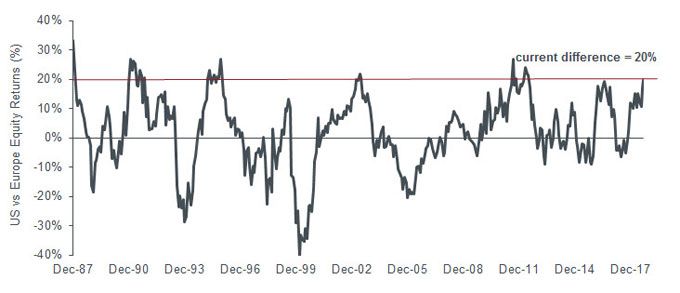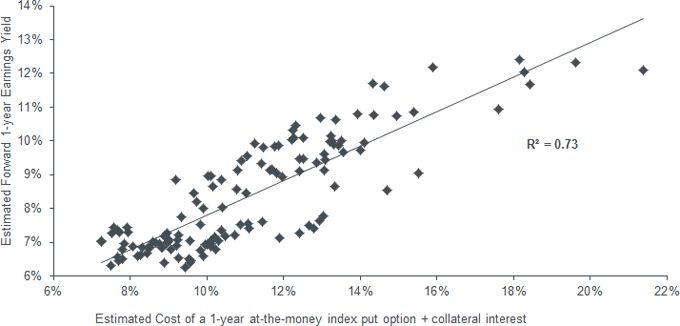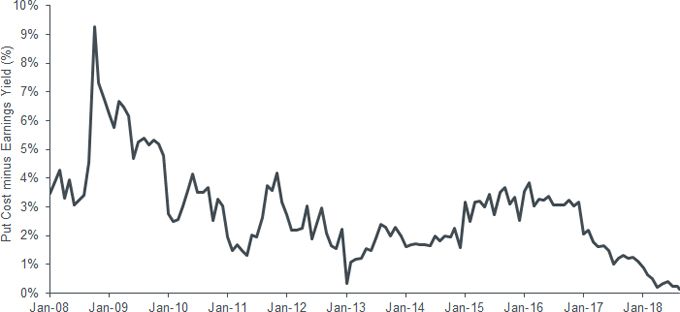
Janus Henderson: Money for nothing, right tails for free
Aneet Chachra, portfolio manager within the Alternatives team, looks at the disconnect between share valuations and option market pricing and what this might imply for European equities.
16.10.2018 | 10:47 Uhr
A geek’s case for European stocks
Over the last year (to 27 September 2018), the US S&P 500 has returned about +18% while the Euro Stoxx 50 has lost -2% in local currency terms. This 20% difference is the widest since the European debt crisis in 2011-2012. It’s also at or near levels from where historically there has been a bounce back in relative performance (Figure 1).
Figure 1: Rolling 1-year relative return % (S&P 500 minus Euro Stoxx 50)

Source: Bloomberg, Janus Henderson, December 1987 to September 2018. Note: Monthly data from unhedged total return series, excludes transaction costs, in local currency.
Past performance is not a guide to future performance
However, more remarkable than the difference in US/European returns is the disconnect between European share valuations and option market pricing.
Broadly, shareholders receive a proportional share of a company’s earnings stream directly or indirectly via dividends, buybacks, or retained/reinvested earnings. Equity holders are positively exposed to the right tail – a rise in share prices as the company expands earnings along with economic growth and inflation. But they also take left tail risk – the firm might shrink or fail. Assuming zero change in valuations or growth, the expected total return for a stock index over the next year is roughly its earnings yield (earnings divided by price).
Importantly, this is only the central expectation and the actual one-year outcome will almost certainly be different. But the key point is shareholders are exposed to both upside benefit and downside risk.
Another way to take equity risk is via option markets. The expected return for bearing the same risk should be roughly similar regardless of implementation method. So when volatility is higher, expected equity return should also be higher to compensate for the additional perceived downside risk.
Data over the last decade confirms this intuition. Figure 2 shows Euro Stoxx 50 expected earnings yield vs the cost of buying a one-year at-the-money1 index put option on it (including interest on collateral). These are closely related as the buyer of an index and the seller of an index put both take the same primary risk – exposure to the downside of a falling equity market.
Figure 2: Euro Stoxx 50 1-year earnings yield vs 1-year ATM put premium (2008-2018)

Source: Bloomberg, Janus Henderson, January 2008 to September 2018. Note: Monthly figures, option prices calculated using market implied volatility and Black-Scholes formula, excludes transaction costs, in euro.
Past performance is not a guide to future performance
Although an equity put seller has nearly all the downside risk of the index, they cap their upside benefit to just the premium received upfront. Therefore, the 1-year put premium should generally be more expensive than the 1-year expected equity return as the put seller has asymmetric risk – on the hook if the index collapses, but limited gain if the index soars. They accept most of the left tail risk without getting the full right tail potential of a shareholder.
Until recently, the Euro Stoxx 50 1-year put premium was indeed higher than the forward earnings yield, but these have now converged (Figure 3). This current combination of high Euro Stoxx 50 earnings yield and low option volatility implies that the right tail has low value i.e. little upside for European stocks. Meanwhile, a similar metric for US stocks is solidly positive with the cost of a 1-year S&P 500 put about 50% above expected earnings yield.
Figure 3: Euro Stoxx 50 1-year ATM put premium minus 1-year earnings yield (2008-2018)

Source: Bloomberg, Janus Henderson, January 2008 to September 2018. Note: Monthly figures, option prices calculated using market implied volatility and Black-Scholes formula, excludes transaction costs, in euro.
Past performance is not a guide to future performance
Despite the sharp drop in European equities, their implied volatility (VSTOXX) remains remarkably low. European markets appear attractive not just compared to US stocks, but also relative to option expectations which imply narrow price moves.
1At the money: This is where an option strike price is identical to the price of the underlying security.




Diesen Beitrag teilen: